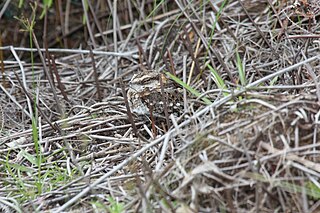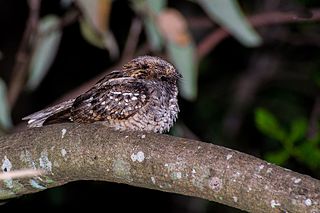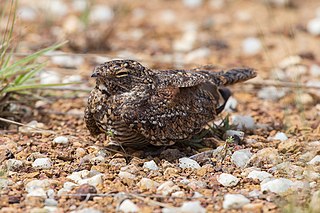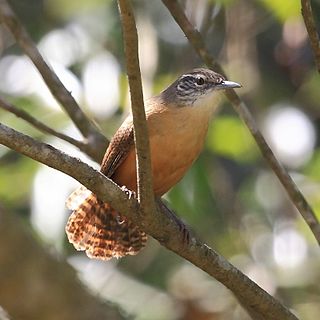
Anthony's nightjar, also known as the scrub nightjar, is a species of nightjar in the family Caprimulgidae. It is found in Ecuador and Peru.

The white-tailed nightjar is a species of nightjar in the family Caprimulgidae. It is found in the "ABC Islands", Brazil, Colombia, Costa Rica, Ecuador, French Guiana, Guyana, Martinique, Panama, Suriname, Trinidad and Tobago and Venezuela.

The Cuban nightjar, is a species of nightjar in the family Caprimulgidae. It is endemic to Cuba.

The Hispaniolan nightjar is a nightjar species endemic to the Caribbean island of Hispaniola, which is shared by the Dominican Republic and Haiti.

The pygmy nightjar is a species of nightjar in the family Caprimulgidae. It is endemic to Brazil.

The spot-tailed nightjar is a species of nightjar in the family Caprimulgidae. It is found in Honduras, Mexico, Nicaragua, and every mainland South American country except Chile and Uruguay.

The blackish nightjar is a species of bird in the family Caprimulgidae. It is found in Brazil, Bolivia, Colombia, Ecuador, French Guiana, Guyana, Peru, Suriname, and Venezuela.

The little nightjar is a species of nightjar in the family Caprimulgidae. It is found in Argentina, Bolivia, Brazil, Paraguay, Peru, and Uruguay.

The rufous nightjar is a species of nightjar in the family Caprimulgidae. It is found in Argentina, Bolivia, Brazil, Colombia, Costa Rica, Ecuador, Guyana, Panama, Paraguay, Peru, Saint Lucia, Suriname, Trinidad and Tobago, and Venezuela.

The least nighthawk is a species of nightjar in the family Caprimulgidae. It is found in Argentina, Bolivia, Brazil, Colombia, Guyana, Suriname, and Venezuela.

The scissor-tailed nightjar is a species of nightjar in the family Caprimulgidae. It is found in Argentina, Bolivia, Brazil, Paraguay, Peru, Suriname, and Uruguay.

The rufous-bellied nighthawk is a species of nightjar in the family Caprimulgidae. It is found in Bolivia, Colombia, Ecuador, Peru, and Venezuela.

The short-tailed nighthawk is a species of nightjar in the family Caprimulgidae. It is found in Mexico, in every Central American country except El Salvador, in Trinidad and Tobago, and in every mainland South American country except Chile and Uruguay.

The swallow-tailed nightjar is a species of nightjar in the family Caprimulgidae. It is found in Bolivia, Colombia, Ecuador, and Peru.

The yellow-billed tern is a small seabird found in South America. It is a species of tern in the family Laridae. It is found in Argentina, Bolivia, Brazil, Colombia, Ecuador, French Guiana, Guyana, Panama, Paraguay, Peru, Suriname, Trinidad and Tobago, Uruguay, and Venezuela. Its natural habitats are rivers, swamps, and freshwater lakes.

The rufous potoo is a species of bird in the family Nyctibiidae. It is found in Brazil, Colombia, Ecuador, French Guiana, Guyana, Peru, and Venezuela.

The Andean potoo is a species of bird in the family Nyctibiidae. It is found in Bolivia, Colombia, Ecuador, Peru, and Venezuela.

The sepia-brown wren or Sharpe's wren is a species of bird in the family Troglodytidae. It is found in Colombia, Ecuador, and Peru.

The buff-breasted wren is a species of bird in the family Troglodytidae. It is found in the Amazon Basin of northern Brazil and Amazonian Colombia, Ecuador, Peru and northern-border Bolivia, and also the Guianan countries of Guyana, Suriname, and French Guiana. It occurs in non-Amazonian regions of Venezuela and Colombia and its range extends into eastern Panama.

The Amazonian trogon, is a near passerine bird in the family Trogonidae, the trogons and quetzals. It is found in Bolivia, Brazil, Colombia, Ecuador, Peru, and Venezuela.























